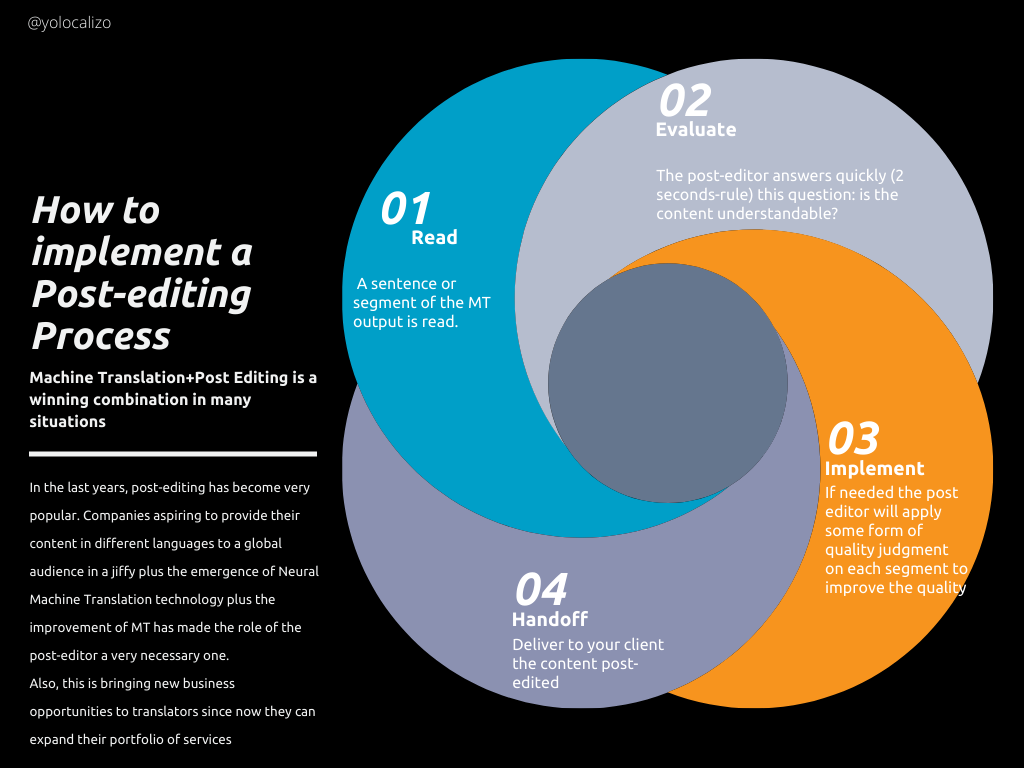Better, faster and well understood! Post-editing strategies
In my house, we breathe an atmosphere of Localization, language, and culture. And not only because all my working life has been practically 100% dedicated to Localization (except for a couple of summers working at a beach club as a waiter, what memories … 🌴☺️) but my wife also dedicates herself to languages, although she does it from a different angle than mine.
She is a German teacher, and although she teaches different groups of different ages, it is true that lately, she is focusing more on the training of future German teachers.
A couple of weeks ago he had some tutoring and she mentioned to me that a student asked the following
“Isabel, what is post-editing? I am getting an offer for this job and I do not understand completely what it is? "
My wife did not know very well either the ins-and-outs of the post-editing world, so she agreed to answer him in the next class. When she commented to me about that question I thought… “I already have a topic for my next post” and I kill 2 birds with one stone since in my blog I have not talked much about this topic and also writing an article I help my wife and her student!
So here we go, this one dedicated to you, Isa!😘
What is post-editing in our industry?
In short, is when we first make the translation of content via machine translation and then a post-editor check the machine's work and give to the copy the human translation quality touch that only a professional translator can I do
Why is post-editing popular today?
As I see it is because of the combination of 5 factors
There is a lot of online content,
Machine translation has greatly improved
There is a global online population that grows every year and consumes content in a language other than English
Every time we like to wait less and we value in many cases more speed than quality( fast and cheap = MT)
For a certain type of content ( i.e. help reference material, FAQ…) quality is not expected to be supreme.
All these factors mean that there is a lot of content generated by Machine Translation, but there are some customers who simply do not want the MT output and consume it directly, and it's in those cases where the post-editor role is essential since machine translation plus post-editing is a hybrid translation approach and it works really well in different fields!
The post-editing process is quite straightforward.
Pitfalls when post-editing
An MT engine produces an initial translation of the material. Once this is done human translators take the text and edit it for accuracy, clarity, fluency, and engagement with the local market, but there are several dangers that a post-editor has to consider when reviewing content generated by MT.
As I see it biggest danger is that we end up over-editing, and that's a problem because to be effective in a post-editing job we have to use MT output as much as we can. We need to resist the temptation to over-edit, change the style or use nice synonyms (or we won’t be productive as the rates for these jobs are low)
Tips for post-editing
Read the instructions very carefully: each client has different guidelines, therefore, be sure to read them and then follow them!
Align expectations with the client what level of quality is expected? And then depending on the answer we can take 2 approaches
Light post-editing process, the editor makes only minimal changes to increase the comprehension of the text. No stylistic changes are required, just the very basic changes, things like very obvious typos, grammatical errors or confusing sentence
Full post-editing is a more extensive process where the post-editor not only corrects obvious mistranslations but also improves the content from other angles such as to adapt cultural references, check terminology with approved termbases, provide consistency and overall improve the fluency
Source: TAUS
How to become a good post editor
As in most cases ... training, and that is that Knowledge changes everything!
TAUS offers workshops and specific training about post-editing
See details here
SDL, another of the giants of our industry also offers training courses in which they prepare us to become brilliant post-editors
See details here
Conclusion
The translator's role evolves as technology evolves and as the requirements of the different jobs we receive evolve. One such requirement is the need to offer post-editing as part of a complete skills portfolio.
Being aware of these new requirements help translators to increase their employability and continue to occupy an important place in the workflow of globalizing content as quickly and cost-efficient.
I hope you found this article interesting, or at least, that my wife or her student finds it useful! ☺️
What about you?
What's your view of post-editing and the post-editor role?
How do you approach post-editing in your team, in your company?
Leave your comments below and have a lovely week!
@ yolocalizo















Words have the power to shape perceptions and influence actions, which is why reframing is such a powerful tool. In localization, we can reframe our role from simply translating to driving alignment across the company. By ensuring content is consistent, culturally relevant, and strategically aligned with business goals, localization professionals play a key role in helping businesses grow globally. This post explores how we create that alignment and why our work is much more than just translation.